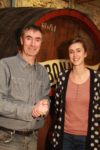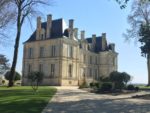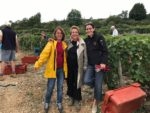Meeting with one of the jewels of Pessac-Léognan
Château Haut-Bailly is a family property located in the Pessac-Léognan appellation, and a Graves Classified Growth (Cru Classé) since 1953. “It’s probably since the Middle Ages that we have been making wine in Haut-Bailly. Our terroir has always interested remarkable men who have known how to unseal its potential and have never ceased to reveal it. As early as 1461, local archives have recorded the excellence of these lands for growing vines. “As the vineyard grew by acquiring plots located around the château, plots still present today in the Haut-Bailly vineyard. From the middle of the 17th century, thanks in particular to Firmin Le Bailly, the plot of the property began to be well established, resembling the current plot. The property remained in the hands of the Le Bailly family until 1736, when the Irish merchant Thomas Barton acquired the estate. The estate would know many and different (and powerful) owners such as the Lafaurie family of Monbadon. It was not until 1872, under the direction of Alcide Bellot des Minières, that the stone house, as we know it today, would be built.
In 1955 the property was sold to Daniel Sanders, then to his son Jean Sanders who kept it until 1998, when it was acquired by Robert G. Wilmers, American billionaire at the head of M&T Bank. He entrusted the management to Véronique Sanders.
Today Château Haut-Bailly covers 30 hectares and produces an average of 160,000 bottles annually divided into four different different labels: Château Haut-Bailly, Haut-Bailly•II, HB (Pessac-Léognan) and Rose de Haut- Bailly (Bordeaux). Château Le Pape (Pessac-Léognan), owned by the same family, was added to the range.
I invite you to set off together to discover this exceptional wine, in the company of Véronique Sanders (Managing Director).
Why did you choose to make wine and not do something else? Has it always been obvious to you?
“After studying literature, economics and communication at the Sorbonne, I worked for a few years as a consultant between Paris, Prague and Hamburg.
But since I was a child, wine has been part of my life and part of my family history. And it was after Haut-Bailly was sold to Robert G. Wilmers in 1998 that I got the management job.
For me, the profession of wine and vines is unique. We are incredibly lucky to be both connected to nature and to an exciting international world. The days go by and each one is different. The richness of our profession makes it a passion above all.”
Where does the name of the property come from?
“The name of the property and of our wine has its origins in one of the notable owners of the château, Firmin Le Bailly, who was a Parisian banker. To tell the truth and to be more precise, he did not buy the domain alone but in association with Nicolas de Leuvarde.
In the 17th century, he acquired the property and gave it its current limits (33 hectares), with the intuition that this terroir has great potential and the capacity to produce a very great wine.
From 1630, Firmin Le Bailly gathered substantial capital which allowed the property to expand to its commercial dimension. The name “Haut-Bailly” was then given to the property, “Haut” since it is positioned on one of the highest ridges on the left bank and “Bailly” in reference to its owner. ”
What terroir do you have? what makes its specificity / its strength?
“Château Haut-Bailly has a unique terroir. Located in the heart of the Graves, the vineyard is established on one of the highest ridges of the left bank of the Garonne and particularly benefits from the topographical advantages of this region as the natural slope allows for efficient drainage. The oceanic climate is also ideal. But beyond the topography and the climate, it is the land which is the most subtle of the three components of the terroir. Rooted in a sandy soil mixed with gravel from a landslide in the tertiary era, the vineyard forms a mosaic of plots with complementary characteristics (drainage, retention of heat and, on the contrary, coolness and humidity). Each of the four grape varieties (Cabernet Sauvignon, Merlot, Cabernet Franc, Petit Verdot) finds its favored land there. The under layer is another specificity of Haut-Bailly: it is made of faluns or petrification of stones and fossilized shells, some specimens of which can be observed on the walls of the cellar. The vines draw from its minerals and nutritional trace elements, which — guarantee – aromatic richness and freshness.
The strength of our terroir, of course, is also our old vines: a plot of 4 hectares of century-old vines where 6 different grape varieties are gathered: Cabernet Sauvignon, Merlot, Cabernet Franc, Malbec, Petit Verdot and Carménère. These old vines constitute around 20% of the final blend. ”
What is the signature of the wines of Château Haut-Bailly? What allows you to recognize them in blind tasting
“The identity of its terroir gives Haut-Bailly a unique style, resulting from a subtle harmony between finesse and concentration, suppleness and structure, soft tannins and aromatic richness: the purity of elegance. Recently, a vertical tasting of 20 vintages was organized in honor of Robert Wilmers which demonstrated the incredible consistency of our wines year after year.
For the ‘Haut-Bailly•II’ wine; to explain it we must make a little historical reminder. Domaine de la Parde was born in 1967, then in 1979 became La Parde de Haut-Bailly. In 2018 La Parde Haut-Bailly was renamed after 50 years of existence. This “N ° II” is assumed to be the reflection of the grand vin. It comes from the same plots as Château Haut-Bailly and is vinified identically. Haut-Bailly•II is the result of strict selection and is distinguished by a marked, charming style, made of racy elegance coupled with finesse. On the palate, it reveals a velvety attack, silky grains, suppleness and pleasant aromas, being free of heaviness. Its freshness and its aromatic opening provide a pleasure that is quickly accessible even though the wine shows a significant aptitude for aging; at least fifteen years.
Regarding Château Le Pape, it produces fruity wines. They are characterized by the freshness and expressiveness of Merlot. These are supple wines, to be tasted 5 to 10 years after bottling. Thanks to the expertise of the Château Haut-Bailly team, Château Le Pape makes gains in precision and elegance. It retains its own style and distinguishes it from other wines in the Haut-Bailly range. ”
Do you have plans for the property?
“We are living in a period of unprecedented technological, scientific and climatic acceleration. Our duty is to adapt to these changes, which is why for several years now we have been preparing the Haut-Bailly of tomorrow. Since July 2018, a new cellar has been under construction: a technical, architectural and environmental feat that we look forward to sharing with you. It will allow us to go even further into detail. ”
Do you have an anecdote about the property
“There is a feeling of authenticity in Haut-Bailly that makes you feel good there. It is a property with a soul. Harmony reigns there. As at Château Le Pape, acquired in 2012 and where we have opened guest rooms, it is a haven of peace in the heart of a vineyard and at the gates of Bordeaux … ”
Thanks to the Château team for their warm welcome.




